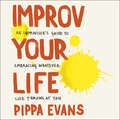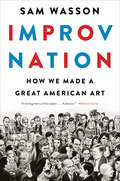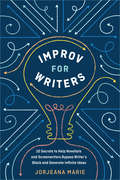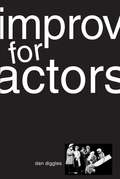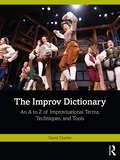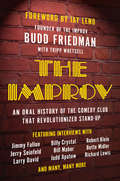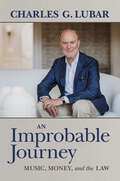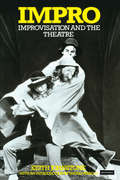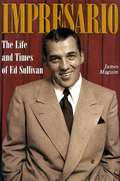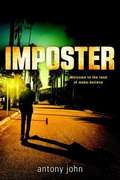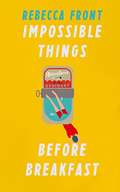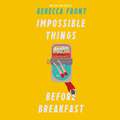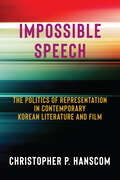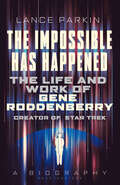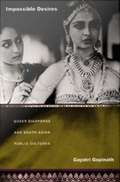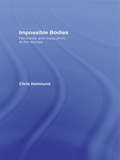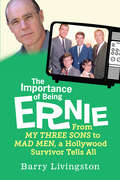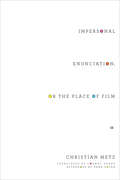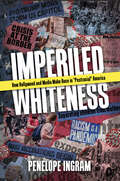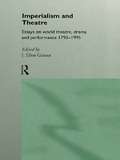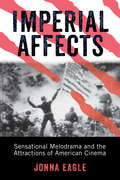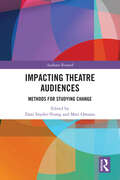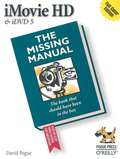- Table View
- List View
Improv Your Life
by Pippa EvansAn improviser's guide to embracing whatever life throws at you!PIPPA EVANS is an expert in saying Yes - and No. She's a master of thinking on her feet, but has also had to learn how to go with the flow. In this book she's passing on everything she's learnt from her award winning improv career, as both a performer and teacher, so YOU can take centre stage in your own life.In telling her story, delving into the craft of improvisation, and sharing fun exercises and practice you can do at home, Pippa will help you become fully yourself - realising your potential and ability to adapt to the ever changing world around you. It's dangerous, being yourself, but let's just take it one step at a time. Open the book, take a breath and get ready to say YES. (If it's a NO from you then perhaps consider buying for a friend, family member or enemy who you think needs some improv-ment)(P) 2021 Hodder & Stoughton Ltd
Improv Nation: How We Made a Great American Art
by Sam Wasson&“Like the best of his subjects, which include Stephen Colbert, Bill Murray and Tina Fey, Wasson has perfect timing.&”—Minneapolis Star-Tribune Finalist for the 2017 George Freedley Memorial Award In this richly reported, scene-driven narrative, Sam Wasson charts the meteoric rise of improv from its unlikely beginnings in McCarthy-era Chicago. We witness the chance meeting between Mike Nichols and Elaine May, hang out at the after-hours bar where Dan Aykroyd hosted friends like John Belushi, Bill Murray, and Gilda Radner, and go behind the scenes of cultural landmarks from The Graduate to The Colbert Report. Along the way, we befriend pioneers such as Harold Ramis, Chevy Chase, Steve Carell, Amy Poehler, Alan Arkin, Tina Fey, Judd Apatow, and many others. &“Compelling, absolutely unputdownable…And, in case you&’re wondering, yes, the book is funny. In places, very funny. A remarkable story, magnificently told.&”—Booklist &“One of the most important stories in American popular culture…Wasson may be the first author to explain [improv&’s] entire history…a valuable book.&”—The New York Times Book Review &“Improv Nation masterfully tells a new history of American comedy…It holds the element of surprise—true to the spirit of its subject.&”—Entertainment Weekly
Improv for Writers: 10 Secrets to Help Novelists and Screenwriters Bypass Writer's Block and Generate Infinite Ideas
by Jorjeana MarieFree yourself from writer’s block and inner critics with the creative power of improv! “Jorjeana Marie’s generous, joyful, and oh-so-useful book shows writers—both seasoned and new—how to unleash their creativity and find their best story.”—Gayle Forman, New York Times bestselling author of If I Stay and I Have Lost My Way Improv instructor and writer Jorjeana Marie reveals a new way to generate idea after brilliant idea. Applying the rules of improv to fiction writing, Marie presents fun games and exercises you can do from the comfort of your desk at home. Surprise yourself with new plots, infinite characters and settings, and a supreme confidence in your own process. Armed with the power of improv—and liberating exercises like Ad Agency, Raise the Stakes, and Family Portraits—you’ll soon be an idea machine. With Improv for Writers, your creative storytelling well will never run dry again.Advance praise for Improv for Writers“Here’s a secret. Many authors started out as drama geeks and later found that theatrical skills like deep-diving into character and improvising on the fly were essential tools for writing fiction. Jorjeana Marie’s generous, joyful and oh-so useful book applies the principles of improv to writing and though a series of targeted, fun exercises shows writers—both the seasoned and the new—how to unleash their creativity and find their best story.”—Gayle Forman, New York Times bestselling author of If I Stay and I Have Lost My Way “Part practical, part playful, part encouraging and affirming, Jorjeana Marie’s Improv for Writers is a certain antidote to writing blocks—and writer’s block! This book is a necessary and vital tool for authors and storytellers everywhere.”—Karma Brown, bestselling author of The Life Lucy Knew“Thank you, Jorjeana Marie for infusing joy and play and experimentation in the often-arduous act of writing fiction. I'll be turning to these exercises whenever I need to jump-start my writing session and will be recommending many of my writing students to do the same.”—Nina LaCour, Michael L. Printz Award-winning author of We Are Okay, Hold Still, The Disenchantments, and Everything Leads to You; and You Know Me Well, a novel written in collaboration with David Levithan.
Improv for Actors
by Dan DigglesIn this step-by-step guide, an actor and improvisational teacher brings his tested methods to the page to show how actors can take risks and gain spontaneity in all genres of scripted theater. Through 28 lessons-each of which includes warm-ups, points of concentration, and improvisation exercises-Improv for Actors provides insights into thinking and reacting with fluidity, exploring a character's social status, using the voice and body as effective tools of storytelling, and more. Actors of all levels will soon be able to give a fresh, original approach to classic characters, create funnier performances in farce and comedy, and make dramatic characters richer and more believable.
The Improv Dictionary: An A to Z of Improvisational Terms, Techniques, and Tools
by David CharlesThe Improv Dictionary: An A to Z of Improvisational Terms, Techniques, and Tools explores improvisational approaches and concepts drawn from a multitude of movements and schools of thought to enhance spontaneous and collaborative creativity.This accessible resource reveals and interrogates the inherited wisdoms contained in the very words we use to describe modern improv. Each detailed definition goes beyond the obvious clichés and seeks a nuanced and inclusive understanding of how art of the moment can be much more than easy laughs and cheap gags (even when it is being delightfully irreverent and wildly funny). This encyclopedic work pulls from a wide array of practitioners and practices, finding tensions and commonalities from styles as diverse as Theatresports, Comedysportz, the Harold, narrative long-form, Playback Theatre, and Boal’s Theatre of the Oppressed. Entries include nuanced definitions, helpful examples, detailed explorations of the concepts in practice, and framing quotes from a leading practitioner or inspirational artistic voice.The Improv Dictionary offers valuable insights to novice improvisers taking their first steps in the craft, seasoned performers seeking to unlock the next level of abandon, instructors craving a new comprehensive resource, and scholars working in one of the numerous allied fields that find enrichment through collaborative and guided play.Each significant entry in the book is also keyed to an accompanying improv game or exercise housed at www.improvdr.com, enabling readers to dig deeper into their process.
The Improv: An Oral History of the Comedy Club that Revolutionized Stand-Up
by Budd Friedman Tripp WhetsellFeatured in the New York Times 2017 "Holiday Gift Guide for Hardcover Fans" Get an insider's oral history of the World's most iconic comedy club, featuring exclusive interviews with today's most hilarious stars recalling their time on stage (and off) at the Improv. In 1963, 30-year-old Budd Friedman—who had recently quit his job as a Boston advertising executive and returned to New York to become a theatrical producer—opened a coffee house for Broadway performers called the Improvisation. Later shortened to the Improv, its first seedy West 44th Street location initially attracted the likes of Judy Garland, Liza Minnelli, Albert Finney, and Jason Robards, as well as a couple of then-unknowns named Dustin Hoffman and Bette Midler. While it drew near-capacity crowds almost from day one, it wasn't until comedians began dropping by to try out new material that the Improv truly hit its stride. The club became the first venue to present live stand-up in a continuous format, and in the process reinvented the art form and created the template for all other comedy clubs that followed. From the microphone to the iconic brick wall, the Improv has been the launching pad for practically every major name in American comedy over the last five-plus decades. Now, in The Improv, Friedman, along with a Who's Who of his most famous alumni—including Jay Leno, Jerry Seinfeld, Jimmy Fallon, Larry David, Billy Crystal, Lily Tomlin, Judd Apatow, Al Franken, Paul Reiser, Howie Mandel, Bob Saget, Drew Carey, and many more—tell it like it was in the first-ever oral history of how this game-changing comedy club came to be. The Improv gives readers an exclusive look at what really happened onstage and off-mic at one of America's most venerable institutions.
An Improbable Journey
by Charles G. LubarAn insider&’s view on blockbuster deal-making and part cultural tour de force, An Improbable Journey is a one-of-a-kind, deeply textured account of how some of the greatest artists of all time pushed to realize their greatest ambitions—with the help of Charles Lubar.The year was 1971. Thirty-year-old Charles Lubar, a Washington, D.C.–born Harvard Law School graduate with a two-and-a-half-year deep dive in the Chief Counsel&’s Office of the Internal Revenue Service recently behind him, was floundering in Nairobi, Kenya where he had come to seek the kind of high-stakes adventures one could never find at a major law firm in the U.S. But with his entrepreneurial hopes quashed in Nairobi by an environment that hardly wrapped its arms around outsiders, Indians being expelled from Kenya, and Idi Amin—the ruthless despot—on the brink of taking over in neighboring Uganda and soon to wreak havoc throughout the region, Lubar decided to pick up his stakes. With a sense of timing that would come to his aid again and again throughout his life, the young lawyer opted to make his next home in the UK. Little did he know that he would soon be swimming hard and fast in 1970s London during a cultural surge of film, television, music, and the stage. &“Hired off the street&” by two American lawyers in London—the brassy entertainment lawyer Irwin Margulies and the corporate transactional lawyer Barry Sterling—Lubar could never have predicted that his work would soon put him front and center at some of the biggest moments with some of the biggest names in showbiz. From the James Bond franchise to Linda Lovelace and &“Deep Throat&”; from Jim Henson and The Muppets to Michael Jackson and the Beatles; from behind the Iron Curtain to the islands of the Netherlands Antilles, Lubar&’s rare knowledge of the tax codes spanning Europe and the U.S. made him an indispensable figure to creatives trying to make their financial lives work on both sides of the Atlantic. His list of clients goes on and on: Bill Graham, John Cleese, Santana, Diana Ross, Frank Oz, Chuck Traynor, Marilyn Chambers, Barbara Bach, Jane Seymour, Shakira, and Enrique Iglesias. Many turned to Lubar in real need of his assistance at the very prime (and sometimes, nadir) of their careers. Lubar&’s bona fides would even land him a spot on the US-UK Fulbright Commission, as President of the Yale Club of London, and a Managing Partner in London of one of the major international law firms. An Improbable Journey shows a risk-taker with his finger living right on the cultural pulse of a moment.
Impro: Improvisation and the Theatre (Bloomsbury Revelations Ser.)
by Keith JohnstoneKeith Johnstone's involvement with the theatre began when George Devine and Tony Richardson, artistic directors of the Royal Court Theatre, commissioned a play from him. This was in 1956. A few years later he was himself Associate Artistic Director, working as a play-reader and director, in particular helping to run the Writers' Group. The improvisatory techniques and exercises evolved there to foster spontaneity and narrative skills were developed further in the actors' studio then in demonstrations to schools and colleges and ultimately in the founding of a company of performers, called The Theatre Machine. Divided into four sections, 'Status', 'Spontaneity', 'Narrative Skills', and 'Masks and Trance', arranged more or less in the order a group might approach them, the book sets out the specific techniques and exercises which Johnstone has himself found most useful and most stimulating. The result is both an ideas book and a fascinating exploration of the nature of spontaneous creativity.
Impresario: The Life and Times of Ed Sullivan
by James MaguireEd Sullivan has nearly 100% name recognition among people 40 and older. In a survey of the fifty most influential programs in the U.S., TV Guide ranked The Ed Sullivan Show #10. The show still appears on PBS and on cable stations across the country. Sixty million baby boomers grew up watching The Ed Sullivan Show. For more than twenty years, from 1948 to 1971, fifty-five million viewers watched The Ed Sullivan Show religiously every Sunday night. Everyone who was anyone appeared--the Beatles and Elvis, of course, and Woody Allen, Bill Cosby, and Elizabeth Taylor, plus public figures such as Fidel Castro, David Ben-Gurion, and Martin Luther King, Jr. More than thirty years later, the program remains a pop-culture icon. But despite Ed Sullivan's prominence, little was known about the private man...until now. Impresario reveals what the Sullivan viewers never saw: nasty, hot-tempered, craven, yet also capable of high ideals and, above all, hugely ambitious. At a time when Americans are looking back, The Ed Sullivan Show stands out as a shining example of television during the golden era. Impresario lets readers look behind the screen to see the man who made it happen.
Imposter
by Antony JohnPerfect for fans of Veronica Mars, this Hollywood thriller explores the blurred lines between Hollywood glamour and reality. Seth Crane has hit rock bottom. His mom recently died, his dad had a stroke and is out of work, and he just lost out on a commercial role. So when a producer shows up at his community theater production and offers him the lead role in an Indie film with major Hollywood buzz, it seems like the answer to all Seth's problems. Seth gets swept up in the Hollywood glamour right away, staying in a fancy hotel, going to the best parties, doing press conferences, and falling for the beautiful starlet Sabrina Layton and then his costar Annaleigh. But things suddenly start popping up in the tabloids--things Sabrina and Annaleigh told him in confidence and that no one else could know--and the line between the film and reality starts to blur. Nothing in Hollywood is what it seems, and Seth has to decide just how far he's willing to go for fame, money, and to protect the people he loves.
Impossible Things Before Breakfast: Adventures in the Ordinary
by Rebecca Front'Hilarious' The Times'I was completely captivated' David SedarisPeople are odd. Even the most predictable of us sometimes defy expectations. Add to that the tricks that life plays on us and the world suddenly seems full of impossible things.As an award-winning actor and writer, Rebecca Front has always been fascinated by life's little quirks. Impossible Things Before Breakfast is a collection of true stories about surprising turns of events, bizarre misunderstandings and improbable life lessons. We learn, among other things, how gazing at the stars can help you communicate with teenagers, how a mushroom can undermine an ancient ritual, and why everyone should wear a cape.Combining elegant writing, wry humour and genuine insight, this brilliant collection prises open the lid on ordinary life and feasts on the impossible.
Impossible Things Before Breakfast: Adventures in the Ordinary
by Rebecca FrontPeople are odd. Even the most predictable of us sometimes defy expectations. Add to that the tricks that life plays on us and the world suddenly seems full of impossible things.As an award-winning actor and writer, Rebecca Front has always been fascinated by life's little quirks. Impossible Things Before Breakfast is a collection of true stories about surprising turns of events, bizarre misunderstandings and improbable life lessons. We learn, among other things, how gazing at the stars can help you communicate with teenagers, how a mushroom can undermine an ancient ritual, and why everyone should wear a cape.Combining elegant writing, wry humour and genuine insight, this brilliant collection prises open the lid on ordinary life and feasts on the impossible.
Impossible Things Before Breakfast: Adventures in the Ordinary
by Rebecca FrontPeople are odd. Even the most predictable of us sometimes defy expectations. Add to that the tricks that life plays on us and the world suddenly seems full of impossible things.As an award-winning actor and writer, Rebecca Front has always been fascinated by life's little quirks. Impossible Things Before Breakfast is a collection of true stories about surprising turns of events, bizarre misunderstandings and improbable life lessons. We learn, among other things, how gazing at the stars can help you communicate with teenagers, how a mushroom can undermine an ancient ritual, and why everyone should wear a cape.Combining elegant writing, wry humour and genuine insight, this brilliant collection prises open the lid on ordinary life and feasts on the impossible.Written and Read by Rebecca Front(p) Orion Publishing Group 2018
Impossible Speech: The Politics of Representation in Contemporary Korean Literature and Film
by Christopher HanscomIn what ways can or should art engage with its social context? Authors, readers, and critics have been preoccupied with this question since the dawn of modern literature in Korea. Advocates of social engagement have typically focused on realist texts, seeing such works as best suited to represent injustices and inequalities by describing them as if they were before our very eyes.Christopher P. Hanscom questions this understanding of political art by examining four figures central to recent Korean fiction, film, and public discourse: the migrant laborer, the witness to or survivor of state violence, the refugee, and the socially excluded urban precariat. Instead of making these marginalized figures intelligible to common sense, this book reveals the capacity of art to address the “impossible speech” of those who are not asked, expected, or allowed to put forward their thoughts, yet who in so doing expand the limits of the possible.Impossible Speech proposes a new approach to literature and film that foregrounds ostensibly “nonpolitical” or nonsensical moments, challenging assumptions about the relationship between politics and art that locate the “politics” of the work in the representation of content understood in advance as being political. Recasting the political as a struggle over the possibility or impossibility of speech itself, this book finds the politics of a work of art in its power to confront the boundaries of what is sayable.
The Impossible Has Happened: The Life and Work of Gene Roddenberry, Creator of Star Trek
by Lance ParkinA biographer goes in search of Gene Roddenberry, creator of the world’s most successful science fiction franchise.This book reveals how an undistinguished writer of cop shows set out to produce “Hornblower in space” —and ended up with Star Trek, an optimistic, almost utopian view of humanity’s future that has been watched and loved by hundreds of millions of people around the world.Along the way, Lance Parkin examines some of the great myths and turning points in the franchise’s history, and Roddenberry’s particular contribution to them. He looks at the view that the early Star Trek advanced a liberal, egalitarian, and multi-racial agenda; charts the various attempts to resuscitate the show during its wilderness years in the 1970s; explores Roddenberry’s initial early involvement in the movies and spin-off Star Trek: The Next Generation (as well as his later estrangement from both), and sheds light on the colorful personal life, self-mythologizing, and strange beliefs of a man who nonetheless gifted popular culture one if its most enduring narratives.
Impossible Desires: Queer Diasporas and South Asian Public Cultures
by Gayatri GopinathBy bringing queer theory to bear on ideas of diaspora, Gayatri Gopinath produces both a more compelling queer theory and a more nuanced understanding of diaspora. Focusing on queer female diasporic subjectivity, Gopinath develops a theory of diaspora apart from the logic of blood, authenticity, and patrilineal descent that she argues invariably forms the core of conventional formulations. She examines South Asian diasporic literature, film, and music in order to suggest alternative ways of conceptualizing community and collectivity across disparate geographic locations. Her agile readings challenge nationalist ideologies by bringing to light that which has been rendered illegible or impossible within diaspora: the impure, inauthentic, and nonreproductive. Gopinath juxtaposes diverse texts to indicate the range of oppositional practices, subjectivities, and visions of collectivity that fall outside not only mainstream narratives of diaspora, colonialism, and nationalism but also most projects of liberal feminism and gay and lesbian politics and theory. She considers British Asian music of the 1990s alongside alternative media and cultural practices. Among the fictional works she discusses are V. S. Naipaul's classic novel A House for Mr. Biswas, Ismat Chughtai's short story "The Quilt," Monica Ali's Brick Lane, Shyam Selvadurai's Funny Boy, and Shani Mootoo's Cereus Blooms at Night. Analyzing films including Deepa Mehta's controversial Fire and Mira Nair's Monsoon Wedding, she pays particular attention to how South Asian diasporic feminist filmmakers have reworked Bollywood's strategies of queer representation and to what is lost or gained in this process of translation. Gopinath's readings are dazzling, and her theoretical framework transformative and far-reaching.
Impossible Bodies: Femininity and Masculinity at the Movies (Comedia)
by Christine HolmlundImpossible Bodies investigates issues of ethnicity, gender, and sexuality in contemporary Hollywood. Examining stars from Arnold Schwarzenegger and Clint Eastwood, to Whoopi Goldberg and Jennifer Lopez, Holmlund focuses on actors whose physique or appearance marks them as unusual or exceptional, and yet who occupy key and revealing positions in today's mainstream cinema. Exploring a range of genres and considering both stars and their sidekicks, Holmlund examines ways in which Hollywood accommodates - or doesn't - a variety of 'impossible' bodies, from the 'outrageous' physiques of Dolph Lundgren and Dolly Parton, to the almost-invisible bodies of Asian-Americans, Latinas and older actors.
The Importance of Being Ernie: From My Three Sons to Mad Men, a Hollywood Survivor Tells All
by Barry LivingstonI SPENT MY ENTIRE LIFE PLAYING NERDS. . .--Barry LivingstonA true Hollywood survivor, Barry Livingston is one of the few child stars who turned early success into a lifelong career. As "Ernie" on the 1960s sit-com My Three Sons--which also featured his real-life brother Stanley as "Chip"--Barry become instantly recognizable for his horn-rimmed glasses and goofy charm. Five decades later, after working on TV shows like Mad Men and Desperate Housewives, and in feature films like Zodiac and The Social Network, Barry Livingston is one actor who knows The Importance of Being Ernie. . .In this fascinating and funny memoir, Barry reveals his most unforgettable anecdotes: Working on set with Fred McMurray, Ozzie and Harriet, Lucille Ball and Dick Van Dyke. Riding a limousine with Elvis Presley. Trying to upstage Ron "Opie" Howard. Even shooting a Superbowl beer commercial with Brad Pitt. At first, Barry's lazy eye and horn-rimmed glasses nearly derailed his career, getting him kicked off his first major film starring Paul Newman. Eventually, his "nerdy" look became his biggest asset, landing Barry a recurring role on Ozzie & Harriet and a regular part on My Three Sons. Fifty years later, Barry is still going strong--from the stage and small screen to to featured film roles opposite Adam Sandler and Robert Downey, Jr.. Like most Hollywood actors, Barry experienced some incredible highs and lows along the way, but he never gave up. "I've been around half a century," he affirms. "And I'm not going away." This is how one child star beat the odds and survived the dark side of the Hollywood dream factory--with charm, wit, determination. . .and big horn-rimmed glasses. This is The Importance of Being Ernie.Barry Livingston has been a professional actor on stage and screen for more than fifty years. Best known for his role as "Ernie" on the long-running TV program, My Three Sons, Livingston continues to appear regularly in feature films and television shows. He is married with two children, and lives in Los Angeles.Praise For The Importance Of Being Ernie"This wryly told saga of a child star who miraculously avoided the crash-and-burn fate of so many of the once-famous. . . an engaging tale of the unusual life of a humorous, modest, and observant man. Barry Livingston delivers a frank and funny tale of TV, movies, and family life." --Brent Maddock, co-author of Tremors and Short Circuit"For a child star, he's almost normal. This poor kid had to sit on William Frawley's lap; we're lucky he's not on a roof with a rifle. . .. Barry is one of those rare child stars who grew up to become an accomplished adult actor. Having logged fifty years in show business, working with everyone from Lucille Ball and Jack Benny to Brad Pitt and Robert Downey, Jr., he's got a great story to tell." --Paul Jackson, Producer Charmed and Sliders."I have known Barry Livingston since he was nine years old. He always made me laugh. Now he's kept me awake reading his wonderful autobiography. There's a lot of talent in those size eight shoes." --Gene Reynolds, director of TV's M.A.S.H.and Promised Land
Impersonal Enunciation, or the Place of Film
by Cormac Deane Christian Metz Dana PolanChristian Metz is best known for applying Saussurean theories of semiology to film analysis. In the 1970s, he used Sigmund Freud's psychology and Jacques Lacan's mirror theory to explain the popularity of cinema. In this final book, Metz uses the concept of enunciation to articulate how films "speak" and explore where this communication occurs, offering critical direction for theorists who struggle with the phenomena of new media. If a film frame contains another frame, which frame do we emphasize? And should we consider this staging an impersonal act of enunciation? Consulting a range of genres and national trends, Metz builds a novel theory around the placement and subjectivity of screens within screens, which pulls in-and forces him to reassess-his work on authorship, film language, and the position of the spectator. Metz again takes up the linguistic and theoretical work of Benveniste, Genette, Casetti, and Bordwell, drawing surprising conclusions that presage current writings on digital media. Metz's analysis enriches work on cybernetic emergence, self-assembly, self-reference, hypertext, and texts that self-produce in such a way that the human element disappears. A critical introduction by Cormac Deane bolsters the connection between Metz's findings and nascent digital-media theory, emphasizing Metz's keen awareness of the methodological and philosophical concerns we wrestle with today.
Impersonal Enunciation, or the Place of Film (Film and Culture Series)
by Christian MetzChristian Metz is best known for applying Saussurean theories of semiology to film analysis. In the 1970s, he used Sigmund Freud's psychology and Jacques Lacan's mirror theory to explain the popularity of cinema. In this final book, Metz uses the concept of enunciation to articulate how films "speak" and explore where this communication occurs, offering critical direction for theorists who struggle with the phenomena of new media. If a film frame contains another frame, which frame do we emphasize? And should we consider this staging an impersonal act of enunciation? Consulting a range of genres and national trends, Metz builds a novel theory around the placement and subjectivity of screens within screens, which pulls in—and forces him to reassess—his work on authorship, film language, and the position of the spectator. Metz again takes up the linguistic and theoretical work of Benveniste, Genette, Casetti, and Bordwell, drawing surprising conclusions that presage current writings on digital media. Metz's analysis enriches work on cybernetic emergence, self-assembly, self-reference, hypertext, and texts that self-produce in such a way that the human element disappears. A critical introduction by Cormac Deane bolsters the connection between Metz's findings and nascent digital-media theory, emphasizing Metz's keen awareness of the methodological and philosophical concerns we wrestle with today.
Imperiled Whiteness: How Hollywood and Media Make Race in "Postracial" America
by Penelope IngramIn Imperiled Whiteness, Penelope Ingram examines the role played by media in the resurgence of white nationalism and neo-Nazi movements in the Obama-to-Trump era. As politicians on the right stoked anxieties about whites “losing ground” and “being left behind,” media platforms turned whiteness into a commodity that was packaged and disseminated to a white populace. Reading popular film and television franchises (Planet of the Apes, Star Trek, and The Walking Dead) through political flashpoints, such as debates over immigration reform, gun control, and Black Lives Matter protests, Ingram reveals how media cultivated feelings of white vulnerability and loss among white consumers. By exploring the convergence of entertainment, news, and social media in a digital networked environment, Ingram demonstrates how media’s renewed attention to “imperiled whiteness” enabled and sanctioned the return of overt white supremacy exhibited by alt-right groups in the “Unite the Right” rally in Charlottesville in 2017 and the Capitol riots in 2021.
Imperialism and Theatre: Essays On World Theatre, Drama, And Performance
by J. Ellen GainorImperialism is a transnational and transhistorical phenomenon; it occurs neither in limited areas nor at one specific moment. In cultures from across the world theatrical performance has long been a site for both the representation and support of imperialism, and resistance and rebellion against it. Imperialism and Theatre is a groundbreaking collection which explores the questions of why and how the theatre was selected within imperial cultures for the representation of the concerns of both the colonizers and the colonized. Gathering together fifteen noted scholars and theatre practitioners, this collection spans global and historical boundaries and presents a uniquely comprehensive study of post-colonial drama. The essays engage in current theoretical issues while shifting the focus from the printed text to theatre as a cultural formation and locus of political force. A compelling and extremely timely work, Imperialism and Theatre reveals fascinating new dimensions to the post-colonial debate. Contributors: Nora Alter; Sudipto Chatterjee; Mary Karen Dahl; Alan Filewood; Donald H. Frischmann; Rhonda Garelick; Helen Gilbert; Michael Hays; Loren Kruger; Josephine Lee; Robert Eric Livingston; Julie S. Peters; Michael Quinn; Edward Said; Elaine Savory.
Imperial Affects: Sensational Melodrama and the Attractions of American Cinema
by Jonna EagleImperial Affects is the first sustained account of American action-based cinema as melodrama. From the earliest war films through the Hollywood Western and the late-century action cinema, imperialist violence and mobility have been produced as sites of both visceral pleasure and moral virtue. Suffering and omnipotence operate as twinned affects in this context, inviting identification with an American national subject constituted as both victimized and invincible—a powerful and persistent conjunction traced here across a century of cinema.
Impacting Theatre Audiences: Methods for Studying Change (Audience Research)
by Dani Snyder-Young Matt OmastaThis edited collection explores methods for conducting critical empirical research examining the potential impacts of theatrical events on audience members. Dani Snyder-Young and Matt Omasta present an overview of the burgeoning subfield of audience studies in theatre and performance studies, followed by an introduction to the wide range of ways scholars can study the experiences of spectators. Consisting of chapter length case studies, the book addresses methodologies for examining spectatorship, including qualitative, quantitative, historical/historiographic, arts-based, participatory, and mixed methods approaches. This volume will be of great interest to theatre and performance studies scholars as well as industry professionals working in marketing, audience development and community engagement.
iMovie HD & iDVD 5: The Missing Manual
by David PogueThe latest versions of iMovie HD and iDVD 5 are, by far, the most robust moviemaking applications available to consumers today. But whether you're a professional or an amateur moviemaker eager to take advantage of the full capabilities of these applications, don't count on Apple documentation to make the cut. You need iMovie HD & iDVD 5: The Missing Manual , the objective authority on iMovie HD and iDVD 5. Even if you own a previous version of iMovie, the new feature-rich iMovie HD may well be impossible to resist. This video editing program now enables users to capture and edit widescreen High Definition Video (HDV) from the new generation of HDV camcorders, along with standard DV and the MPEG-4 video format. iMovie HD also includes "Magic iMovie" for making finished movies automatically. The feature does everything in one step--imports video into separate clips and adds titles, transitions, and music. The finished video is then ready for iDVD 5, which now includes 15 new themes with animated drop zones that can display video clips across DVD menus, just like the latest Hollywood DVDs. This witty and entertaining guide from celebrated author David Pogue not only details every step of iMovie HD video production--from choosing and using a digital camcorder to burning the finished work onto DVDs--but provides a firm grounding in basic film technique so that the quality of a video won't rely entirely on magic. iMovie HD & iDVD 5: The Missing Manual includes expert techniques and tricks for: *Capturing quality footage (including tips on composition, lighting, and even special-event filming) *Building your movie track, incorporating transitions and special effects, and adding narration, music, and sound *Working with picture files and QuickTime movies *Reaching your intended audience by exporting to tape, transferring iMovie to QuickTime, burning QuickTime-Movie CDs, and putting movies on the Web (and even on your cell phone!) *Using iDVD 5 to stylize and burn your DVD creation. iMovie HD & iDVD 5: The Missing Manual --it's your moviemaking-made-easy guide.
